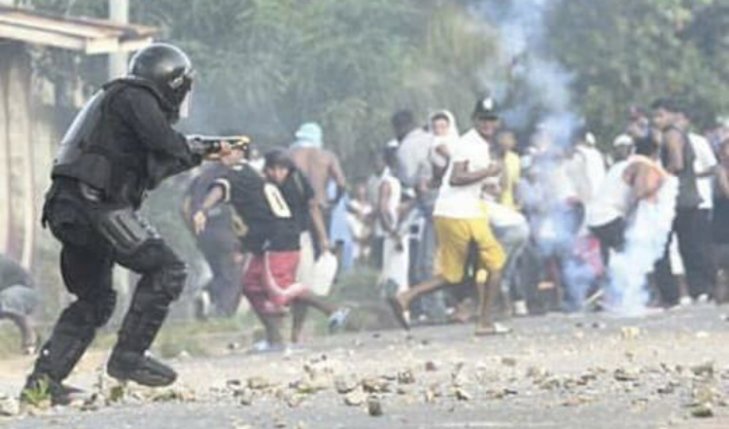
by Deep Green Resistance News Service | Nov 10, 2017 | Colonialism & Conquest
by Laura Herlihy / Intercontinental Cry
The Nicaraguan Sandinista (FSLN) government of Daniel Ortega and the indigenous Miskitu people are repeating their own history. Resembling the Cold War era of the 1980s, violence is playing out again along the Caribbean Coast. At least four indigenous Miskitu men are dead, several are missing, and many more have been taken as political prisoners and prisoners of conscience in the violent anti-indigenous riots that followed the municipal election in Bilwi-Puerto Cabezas on Sunday, Nov. 5.
A few hours after polls closed, officials from the indigenous political party Yatama (Yapti Tasba Masraka Nanih Aslatakanka/Children of the Mother Earth), calculated having nearly 3,000 more votes than the opposition FSLN party. While Yatama officials awaited the arrival of ballot boxes from their loyal communities, the FSLN claimed victory and celebrated shortly after 10:00 PM. The following day, Yatama officials denounced the FSLN for lack of transparency in the election; they also claimed to have documented electoral fraud and voter suppression, through the manipulation of voter data, multiple voting by FSLN sympathizers (by using removable ink on their thumbs); and the purchasing of votes.
Yatama held a protest march on Monday afternoon but were confronted by Riot Police brought in from Managua, backed by Sandinista youth gangs. The Riot Police reportedly turned a blind eye to the gang’s destruction of property belonging to Yatama sympathizers, including costly vehicles.

A car set on fire during the massive riot lights up the night
Later, both the Yatama headquarters (a sacred temple of indigenous identity) and Radio Yapti Tasba (Yatama’s indigenous language-based, community radio station) were destroyed by fire.

Rampant destruction across Biliw (also known as Puerto Cabezas) included the YATAMA Indigenous party headquarters and both of their radio stations, leaving the Sandinista radio station as the only operating, on-air station in a region which relies on community radio as a prime source of information
The FSLN flag was then mounted high upon the surviving radio tower, replacing Yatama’s flag.

Raising of the FSLN flag
Perhaps most symbolically, the iconic statue of the Indian (“El Indio”) was demolished in Bilwi’s town center. The statue, erected decades ago, represented the indigenous struggle. Caribbean coastal residents lost a significant amount of their cultural patrimony in one volatile day.

The iconic statue before it was destroyed

Local intellectuals claim this election and its aftermath symbolize the final conquest and domination of the Muskitia region, finishing off what Rigoberto Cabezas initiated in 1894, when he incorporated the Muskitia territory into Nicaragua and ousted the last Miskitu King, Robert Henry Clarence. Today, in a similar way, the Sandinista state attempts to eliminate the long-term spiritual and political leader of the Miskitu people, Brooklyn Rivera, and the Yatama organization he founded almost 30 years ago to the day, on Nov. 11, 1987.
Para-military forces apprehended Rivera the afternoon of Monday, Nov. 6, but he escaped when Yatama youth fought his captors. Rivera and other top Yatama leaders (Reynaldo Francis, Bilwi’s 2017 Yatama mayoral candidate, and Elizabeth Henriquez) are now in hiding, threatened by arrest warrants and the burning of their houses by FSLN sympathizers. Their children also remain in hiding, along with many Yatama officials and their family members.
Since 2008, a new wave of colonization has occurred in the Nicaraguan Muskitia by mestizo agricultural and cattle-ranching colonists from the Pacific. Colonists cut down trees in ancestral, indigenous rainforest lands, illegally settle in the region, and vote Sandinista.
To date, in their fight with the colonists, 44 Miskitu men have been killed, 22 have been kidnapped, and dozens have been injured. These indigenous environmental activists are protecting their rainforest lands for the global good. The IACHR (Inter-American Commission on Human Rights) passed two resolutions in 2015 and 2016, urging the state to protect the Miskitu people, but the Nicaragua state has not complied.
Accused Sandinista aggressions since the Municipal Elections include:
- Arbitrary repression and imprisonment of indigenous people.
- Burning of indigenous community radio station Yapta Tasba of the Yatama organization.
- Burning of the Yatama headquarters that served as a scared temple for its indigenous supporters.
- Criminalization of Yatama leaders, including the detainment of long-term leader and national congressman Brooklyn Rivera, who escaped from para-military police.
- Destruction of monuments: the Indian statue in the town’s center that stood as a symbol of indigenous resistance for 30 years.
- Suppression of the Yatama flag by the FSLN flag.
- Militarization of communities with Riot Police, who voted in local elections although not residents.
- At present, the Riot Police from Managua are fighting with automatic weapons against indigenous Yatama youth armed with mainly mortar, rocks, handguns, and knives.
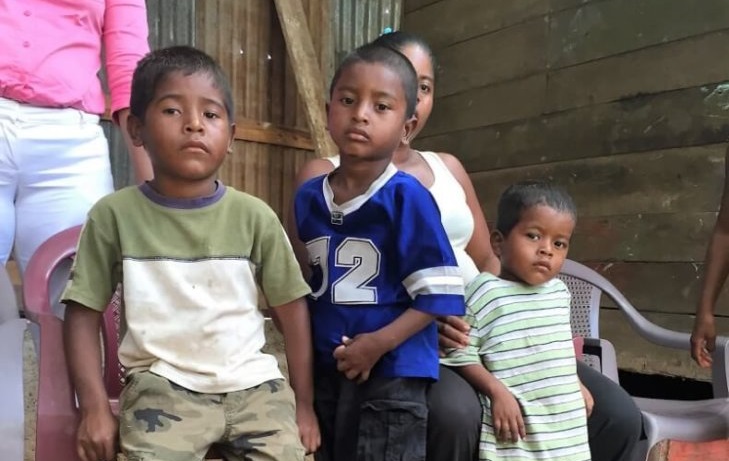
by Deep Green Resistance News Service | Oct 18, 2017 | Colonialism & Conquest
Featured image: Three young brothers and their mother, from a family with 6 children overall – Internally Displaced Persons (IDPs) who fled to Bilwi, Nicaragua in August of 2015 from the frontier community of Santa Clara. Their family is struggling to get by in Bilwi; they are not used to needing money to survive. They don’t consider Bilwi their home and only wish for peace to be restored in the frontier community of Santa Clara so they may return to live in their traditional ways on their legal, traditional land. Photo by Courtney Parker. 2016
by Courtney Parker / Intercontinental Cry
One day after she received an ominous warning, Indigenous Community Judge Celedonia Zalazar Point and her husband, Tito José González Bendles, were shot to death by Colonos in the northern Caribbean region of Nicaragua, a region that has been plagued by an escalating land conflict with illegal settlers since at least 2015. The unthinkable double homicide took place in the Tungla, Prinzu Awala Indigenous territory—Judge Celedonia Zalazar Point’s jurisdiction in the municipality of Prinzapolka.
La Prensa journalist, José Garth Medina, reported a statement from The Center for Justice and Human Rights of the Atlantic Coast (Cejudhcan) on Sept. 8, the date of the killings, concluding that the settlers entered the family home and killed both husband and wife with firearms.
Despite claims issued by local authorities regarding pending investigations into this most recent incident, Medina reminded readers that the November 2016 massacre (which IC also reported on) of a Mayanga family by Colono invaders, has yet to generate any arrests.
Colonos are armed, Mestizo imperialist settlers who are terrorizing Nicaragua’s Indigenous communities. Their endgame varies from one faction to the next; however most of them are interested in expanding the agricultural frontier with cattle farms or illegal mining interests—an effort that runs parallel to what has been happening across the Amazon for decades.
Many Colonos are also in possession of illegal land permits that grant them ownership to traditional Miskito lands.
In fact, the Indigenous territories of the northern Caribbean coast, where this recent double homicide took place, is also home to the largest tropical rainforest second only to the Amazon rainforest in the Western Hemisphere. The Bosawás Biosphere Reserve received official UNESCO designation as a biosphere reserve in 1997.
La Inicativa Mesoamericana de Mujeres Defensoras de Derechos Humanos (IM-Defensoras) has issued a call on the international human rights community “to remain vigilant about the grave situation facing the indigenous communities of the Caribbean Coast.” They called on Nicaraguan authorities to investigate the double homicide of the community judicial leader and her spouse; and in the process, end the culture of impunity that surrounds the ongoing murders of Indigenous Peoples in Nicaragua.
Even amidst the Guardian’s largely publicized partnership with Global Witness—a human rights watchdog group that has defended their methods, model, and investigation into the killings in Nicaragua after receiving waves of criticism from leftist groups operating ‘in solidarity’ with the Sandinista/Ortega government—the Guardian now appears unwilling to directly address the wave of deadly violence in Nicaragua, or even utter the country’s name in articles stemming from the partnership.
While the individual names of the judge and her spouse are listed at the top of their ‘recent killings list’, the Guardian‘s most recent published article, dated Oct. 11, makes no mention of the couple, let alone the cold-blooded colonialism that drove their murders.
To be sure, Community Judge Celedonia Zalazar Point and her husband, Tito José González Bendle, were killed by senseless colonial, greed-fueled violence in a country that has ironically managed to brand itself in many circles of international human rights discourse as a global leader of Indigenous rights recognition. Behind the scenes, the Indigenous Peoples of the northern Caribbean coast have been begging for years to FSLN/Sandinista authorities to end the culture of impunity that surrounds—and establishes a complicity in—this slow burning genocide.
Community leader, Brooklyn Rivera, has had his name smeared through the mud from every side but he’s still treated like a modern day mythic hero when he travels the frontier, which unlike the loud-mouthed Gringo ‘Sandal-istas’ who got caught up in the romance of a campesino revolution in the 1980’s—and have been unwilling to update their internal programming to recognize the economic and political ideological shifts that have taken place in the Sandinista model under Ortega—he travels to these violence-torn communities regularly. He is recognized everywhere he goes, every much the leader he was when Russell Means of the American Indian Movement (AIM) fought by his side during the last Indian wars.
The Moskito Council of Elders, led by Chief of the Elders, Ottis Lam Hoppington, are an entirely separate faction of tribal political influence in Moskitia and have no direct connections to Brooklyn Rivera or the various factions of the Indigenous political party of YATAMA that have emerged over the years. And yet, the message they send to the world is the same.
The colonial violence and invasion, which has greatly escalated since June of 2015 according to Hoppington, has disrupted their ancient way of life and connection to the land—and even disrupted the natural cycles of the region to the point of drying up rivers, causing animals to migrate, and causing the climate patterns to shift. The residents of Moskitia have been vigilant stewards of one of the most biodiverse areas in the world since ancient times; and, this is all being threatened – the Indigenous Peoples’ lives, and the climate mitigating biodiverse forest—by armed factions who, according to Hoppington, are directly supported by the Ortega government.

Chief of the Moskito Council of Elders, Otis Lam Hoppington, on the far left. Photo taken by Courtney Parker in February of 2016 in Bilwi, Nicaragua as the Elders met to discuss their list of demands from the YATAMA political party in a private meeting preceding the YATAMA conference in February of 2016.
In a statement collected from Brooklyn Rivera last year, he explains in great detail, the de-evolution of relations between the residents of Moskitia and the Sandinista government. This history ranges from a time of civil war when Indigenous villages were burned to the ground by the Marxist revolutionaries and tens of thousands of Indigenous individuals were internally displaced. Later, the Indigenous leaders of the region still gave Ortega and the FSLN another chance to make things right – for two election cycles – until it became apparent that the FSLN’s hollow apologies for their human rights violations on the Indigenous Peoples of Moskitia committed in the past were just empty rhetoric, hiding their real intentions to expand and nationalize the autonomous ancient Indigenous territory once and for all.
Accordingly, in the past few years, the region has been exercising more and more political autonomy which has resulted in a long line of violent attacks on Indigenous leadership in the quasi-urban Indigenous city of Bilwi – called Puerto Cabezas by colonists. This has occurred in tandem with the escalated violence and terrorism by Colonos inflicted on the frontier where Indigenous Peoples of Moskitia attempt to maintain their ancient lifestyles.
Many of the refugees fleeing to Bilwi from the frontier have never had to use money to acquire housing or food. A large percentage don’t even speak Spanish – only Miskito, the language which defines their lived experience on the frontier – and are marginalized further by this micro-cultural barrier when fleeing to Bilwi or other relatively urban regions.
Of course, the modern border to Honduras does not mean much to Indigenous Peoples of the region, as there have been Miskitos living, since ancient times, on either side of the dotted line. Yet, for whatever reason, masses have somehow been able to escape the encroaching settler violence on the Nicaragaua side, by crossing into modern-day Honduras, a part of the ancient ‘binational’ Indigenous territory of Moskitia.
This geopolitical anomaly (which has proven inconvenient for some ideologically entrenched ‘human rights groups’) seems to further disrupt the prevailing narrative that U.S. funded factions in Honduras have produced the deadliest violence towards all land defenders in Latin America. They certainly have produced an inexcusable amount of violence by any measure, but as the October 11tharticle in The Guardian noted on Honduras, their official body count of murdered land rights’ defenders for 2017 is ‘one’; and, is once again trailing behind Nicaragua’s death toll for the current year.
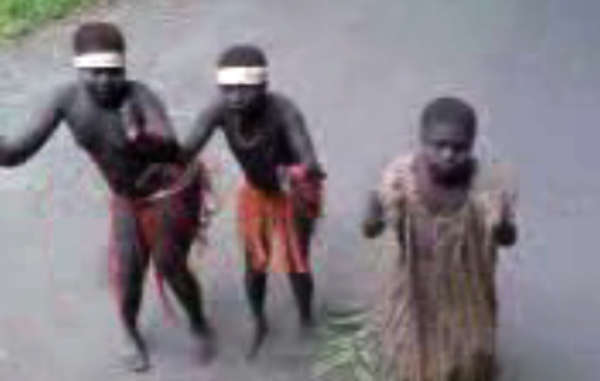
by Deep Green Resistance News Service | Oct 17, 2017 | Colonialism & Conquest
Featured image: Still from video showing Jarawa girls forced to dance for tourists along the illegal Andaman Trunk Road. © Anon
by Survival International
Tour operators in India’s Andaman Islands are selling “human safaris” to the reserve of a recently-contacted tribe, despite government promises to ban the practice.
Tourists travel along a road through the Jarawa’s forest, treating tribespeople like animals in a safari park. In 2013, the Andaman government promised to open a sea route to the Islands’ most popular tourist destinations, which would stop tourists needing to drive through the Jarawa’s reserve. The sea route has recently become operational.
But despite the authorities’ commitment to ensuring all tourists would have to use the sea route, very few currently do, and the market in human safaris along the road is flourishing.
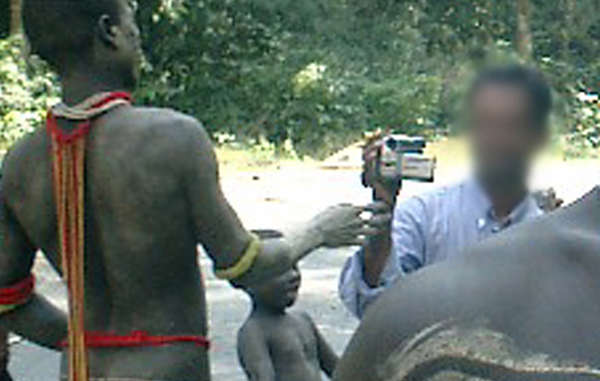
A tourist films a Jarawa man up close on the road. Campaigners have raised deep concerns about the dangerous, degrading and exploitative nature of tribal tourism. © Survival
One tour company, Tropical Andamans, states that: “The Famous Jarawa creek is a lonely planet in itself. It is the dwelling place of the oldest tribes found in these islands. The tribes known as Jarawas, are aloof from the civilized world. They are the wonder of the modern world, for they feed on raw pigs, fruits, and vegetables. They don’t speak any language known to general public. Their pitch black skin and red eyes will leave you dazzled in case you happen to meet them.”
A tourist website, Flywidus, offers a glimpse of “primitive tribals” to tourists driving through the Jarawa reserve, and another, Holidify, describe the Jarawa as a “major attraction” and claims that the Jarawa “love the high of specific drugs, one of it being tobacco.”
In 2002 India’s Supreme Court ordered the road closed, but it has remained open continuously despite pressure from human rights campaigners.
Survival International led a global campaign against the human safaris, calling for a boycott of the Andaman tourist industry until they came to an end. Nearly 17,000 people from around the world pledged not to holiday in the islands in protest.
In a recent statement, the Andaman government said that the road: “…shall remain open for the use of both islanders and the tourists as no decision has been taken by this Administration for closing it down for the tourists. However, the tourists have been advised to avail boat service.”
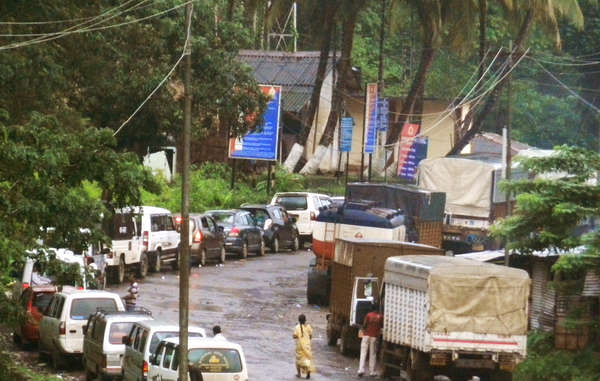
Tourist vehicles queuing to enter the Jarawa tribal reserve. © www.andamanchronicle.net /Survival
Background briefing
– The road brings a daily invasion of hundreds of tourists into the heart of the Jarawa reserve. The promotion by tour operators of sightings of the Jarawa is illegal in the islands, but this is not being enforced.
– The UN, India’s Minister for Tribal Affairs and members of the European Parliament have all condemned the practice.
– One tourist described his trip: “The journey through tribal reserve was like a safari ride as we were going amidst dense tropical rainforest and looking for wild animals, Jarawa tribals to be specific.”
– The Jarawa, like all recently contacted peoples, face catastrophe unless their land is protected.
– The human safaris are also dangerous – one Jarawa boy lost his arm after tourists threw food at him from a moving vehicle. They sparked global outcry in 2012 after footage emerged of a tourist forcing several Jarawa girls to dance.
– Tribal peoples’ land rights have been part of international law for generations. The key to their survival and prosperity is to ensure their land remains under their control.
– All uncontacted and recently contacted tribal peoples face catastrophe unless their land is protected. Survival International is leading the global fight to secure their land for them, and to give them the chance to determine their own futures.
Survival’s Director Stephen Corry said: “The new sea ferry was supposed to stop tour buses driving through Jarawa land, and so put an end to these dangerous and disgusting human safaris. But the government wants it to be optional which defeats the purpose entirely. Tourist companies are still selling the safaris and profiting from the exploitation of tribal people. Ethical tourists should boycott the islands until this is stopped.”
by Deep Green Resistance News Service | Sep 25, 2017 | Colonialism & Conquest
Featured image: World Wildlife Fund (WWF) has been working in the Congo Basin for decades – supporting squads who have committed violent abuse against tribal people. © WWF
by Survival International
A new Survival International report details widespread and systematic human rights abuses in the Congo Basin, by wildlife guards funded by the World Wildlife Fund (WWF) and other big conservation organizations.
The report documents serious instances of abuse between 1989 and the present day in Cameroon, the Republic of Congo, and the Central African Republic (CAR) by guards funded and equipped by WWF and the Wildlife Conservation Society (WCS), the parent organization of New York’s Bronx zoo.
It lists more than 200 instances of abuse since 1989, including pouring hot wax onto exposed skin, beating, and maiming with red-hot machetes. These incidents are likely just a tiny fraction of the full picture of systematic and ongoing violence, beatings, torture and even death.
As well as these especially cruel incidents, the report also documents the forms of harassment that have become part of everyday life for many people, including threats, and the destruction of food, tools and personal belongings.
Read the full report here.
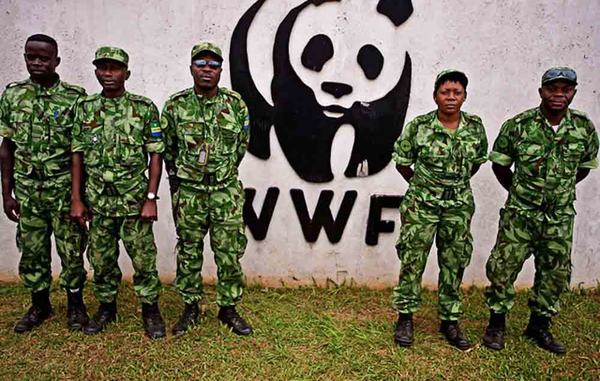
WWF funded guards in Gabon. © WWF
As well as Survival, over the past three decades, numerous independent experts and NGOs have raised concerns about these abuses. These have included NGOs like Greenpeace, Oxfam, UNICEF, Global Witness, Forest Peoples Programme, and research specialists from University College London, the University of Oxford, Durham University, and Kent University.
WWF and WCS have even partnered with several logging companies, despite evidence that their activities are unsustainable, and have not had the consent of tribal peoples as required by international law and their own stated policies.
One Bayaka man said: “A wildlife guard asked me to kneel down. I said: “Never, I could never do that.” He said: “If you don’t get down on your knees I’m going to beat you.”
A Baka woman said: “They took me to the middle of the road and tied my hands with rubber cord. They forced my hands behind my back and cut me with their machete.”

Survival has documented hundreds of instances of abuse, and collected testimonies from many “Pygmy” people. © Survival International
A Bayaka woman said: “They started kicking me all over my body… I had my baby with me. The child had just been born three days before.”
Tribal peoples have been dependent on and managed their environments for millennia. Their lands are not wilderness. Evidence proves that tribal peoples are better at looking after their environment than anyone else.
But big conservation organizations like WWF are partnering with industry and tourism and destroying the environment’s best allies. Now tribal people are accused of “poaching” because they hunt to feed their families. And they face arrest and beatings, torture and death, while big game trophy hunters are encouraged.
Survival’s Director Stephen Corry said: “This shocking report lays out, in detail, the abuse and persecution that “conservation” has brought the indigenous and tribal peoples of the Congo Basin. These are just the cases that have been documented, it’s impossible to imagine there aren’t a lot more which remain hidden.
“The big conservation organizations should admit that their activities in the region have been catastrophic, both for the environment and for the tribal peoples who guarded these forests for so long.
“WWF and WCS supporters might ask these organizations how they could have let this situation carry on for so long – and what they’re going to do now to make sure it stops.”
“Pygmy” is an umbrella term commonly used to refer to the hunter-gatherer peoples of the Congo Basin and elsewhere in Central Africa. The word is considered pejorative and avoided by some tribespeople, but used by others as a convenient and easily recognized way of describing themselves.
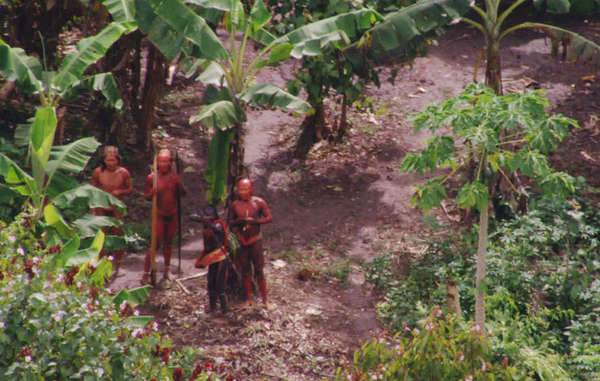
by Deep Green Resistance News Service | Sep 14, 2017 | Colonialism & Conquest, Mining & Drilling
Featured image: A still from aerial footage from 2011 of an uncontacted Amazon tribe in Brazil near the Peruvian border. © BBC/FUNAI/Survival
by Survival International
Brazilian Indians have appealed for global assistance to prevent further killings after the reported massacre of uncontacted tribespeople, and have denounced the government cuts that left their territories unprotected.
Paulo Marubo, a Marubo indigenous leader from western Brazil, said: “More attacks and killings are likely to happen. The cuts to FUNAI’s funding are harming the lives of indigenous people, especially uncontacted tribes, who are the most vulnerable.” (FUNAI is Brazil’s indigenous affairs agency).
Mr. Marubo is the leader of Univaja, an indigenous organization defending tribal rights in the Uncontacted Frontier, the area with the highest concentration of uncontacted tribes in the world.
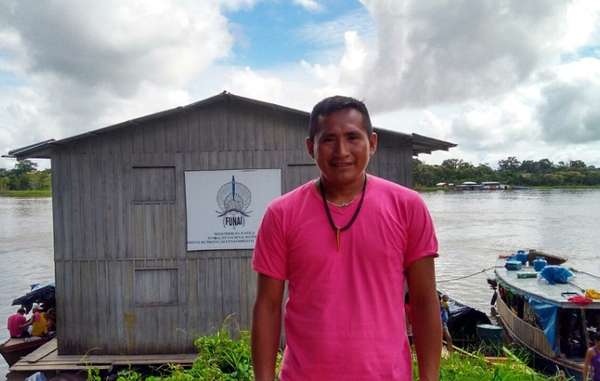
Paulo Marubo, leader of a Javari Valley indigenous organization from the Uncontacted Frontier. © Amazonas Atual
COIAB, the organization representing Indians across the Brazilian Amazon, denounced the massive cutbacks to FUNAI’s budget that has left many tribal territories unprotected:
“We vehemently condemn these brutal and violent attacks against these uncontacted Indians. This massacre shows just how much the rights of indigenous peoples in this country have been set back [in recent years].
“The cuts and dismantling of FUNAI are being carried out to further the interests of powerful politicians who want to continue ransacking our resources, and open up our territories for mining.”
Unconfirmed reports first emerged from the Amazon last week that up to 10 uncontacted tribal people had been killed by gold miners, and their bodies mutilated and dumped in a river.
The miners are reported to have bragged about the atrocity, whose victims included women and children, in a bar in a nearby town. The local prosecutor’s office has opened an investigation.
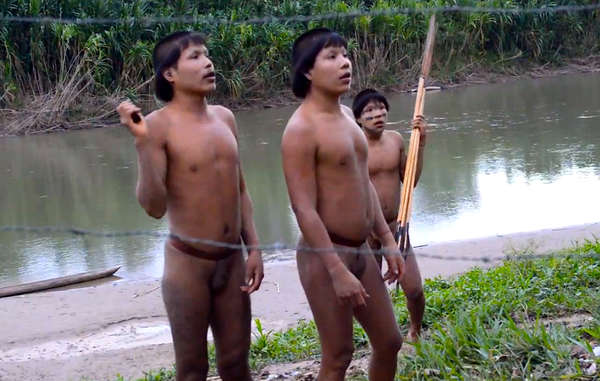
These Sapanawa Indians made contact in 2014. They reported their community had been attacked, and so many members of the village killed that they could not bury the dead. © FUNAI/Survival
The alleged massacre was just the latest in a long line of previous killings of isolated Indians in the Amazon, including the infamous Haximu massacre in 1993, in which 16 Yanomami Indians were killed by a group of gold miners.
More recently, a group of Sapanawa Indians emerged in the Uncontacted Frontier, reporting that their houses had been attacked and burnt to the ground by outsiders, who had killed so many members of the community that they had not been able to bury all the bodies.
All uncontacted tribal peoples face catastrophe unless their land is protected. Survival International is campaigning to secure their land for them, and to give them the chance to determine their own futures.
Survival’s Director Stephen Corry said: “The decision by the Brazilian government to slash funding for the teams that protect uncontacted Indians’ territories was not an innocent mistake. It was done to appease the powerful interests who want to open up indigenous lands to exploit – for mining, logging and ranching. These are the people the Indians are up against, and the deaths of uncontacted tribes won’t put them off. Only a global outcry can even the odds in the Indians’ favor, and prevent more such atrocities. We know public pressure works – many Survival campaigns have succeeded in the face of similar odds.”
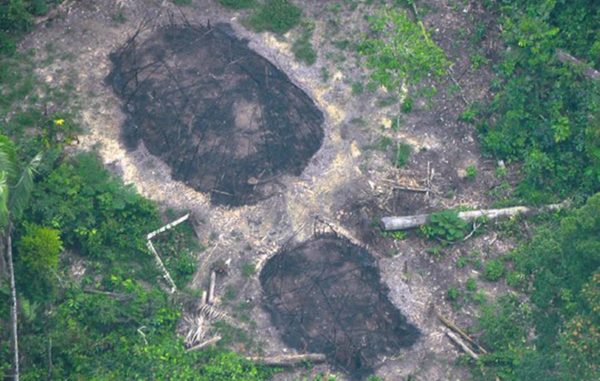
by Deep Green Resistance News Service | Sep 9, 2017 | Colonialism & Conquest
Featured image: Evidence of an attack? Burnt communal houses of uncontacted Indians, seen in December 2016, could be signs of another massacre in the Uncontacted Frontier. © FUNAI
by Survival International
Public prosecutors in Brazil have opened an investigation after reports that illegal gold miners in a remote Amazon river have massacred “more than ten” members of an uncontacted tribe. If confirmed, this means up to a fifth of the entire tribe have been wiped out.
Two miners have been arrested.
The killings allegedly took place last month along the River Jandiatuba in western Brazil, but the news only emerged after the miners started boasting about the killings, and showing off “trophies” in the nearest town.
Agents from Brazil’s indigenous affairs agency, FUNAI, confirmed details of the attack to Survival International. Women and children are believed to be among the dead. FUNAI and the public prosecutor’s office are currently investigating.
The area is known as the Uncontacted Frontier, as it contains more uncontacted tribes than anywhere else on Earth.
Several government teams who had been protecting uncontacted indigenous territories have recently had their funding slashed by the Brazilian government, and have had to close down.
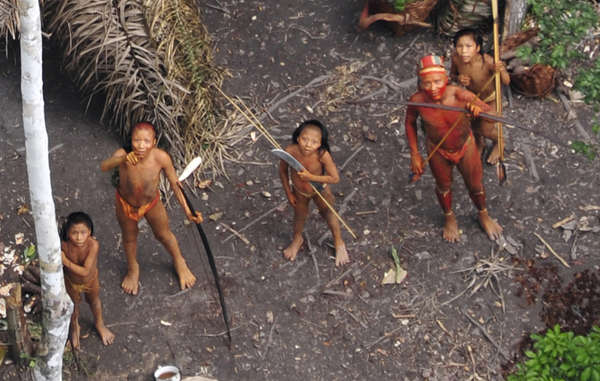
Uncontacted Indians in the Brazilian Amazon, filmed from the air in 2010. © G.Miranda/FUNAI/Survival
President Temer’s government is fiercely anti-Indian, and has close ties to the country’s powerful and anti-indigenous agribusiness lobby.
The territories of two other vulnerable uncontacted tribes – the Kawahiva and Piripkura – have also reportedly been invaded. Both are surrounded by hundreds of ranchers and land invaders.
Uncontacted tribes are the most vulnerable peoples on the planet. However, when their rights are respected, they continue to thrive.
All uncontacted tribal peoples face catastrophe unless their land is protected. Survival International is doing everything it can to secure their land for them, and to give them the chance to determine their own futures.
Survival’s Director Stephen Corry said: “If these reports are confirmed, President Temer and his government bear a heavy responsibility for this genocidal attack. The slashing of FUNAI’s funds has left dozens of uncontacted tribes defenseless against thousands of invaders – miners, ranchers and loggers – who are desperate to steal and ransack their lands. All these tribes should have had their lands properly recognized and protected years ago – the government’s open support for those who want to open up indigenous territories is utterly shameful, and is setting indigenous rights in Brazil back decades.”


















